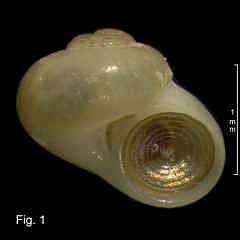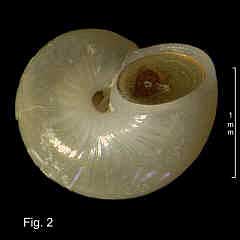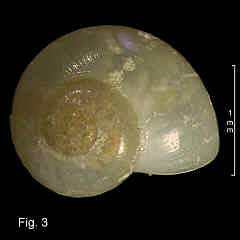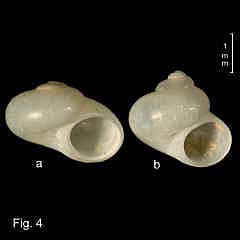|
|
|
|
|
Cirsonella weldii (Tension-Woods, 1877) Description: Shell minute, variable in height to width ratio (See Fig. 4). Protoconch low, smooth, with well defined transition to teleoconch. Teleoconch up to 3 whorls. Whorls rounded, smooth or with irregular axial growth lines. Umbilicus open, deep, partly closed by inner lip of aperture; base surrounding umbilicus usually rounded, occasionally angled, and rarely with funicle. Aperture circular, peristome entire or nearly so, outer lip thin, inner lip thickened. Shell colourless transparent when fresh, becoming opaque white with age. Size: Up to 3.2 mm wide, 2.9 mm high. Distribution: Endemic to Australia; Known from Cape Moreton, Queensland, southwards around southern Australia to western Great Australian Bight, including Tasmania. Habitat: Occasionally found in beach washup, but more frequently subtidal, down to 300 m. Common. Comparison: Cirsonella carinata is similar but smaller, has a taller spire and has spiral threads and a spiral rib around the umbilicus. Synonymy: Cirsonella australis Angas, 1877 is a previously recognised synonym. Crossea naticoides Hedley, 1907 (Fig. 5) is a synonym based on shells with an angled entry to the umbilicus, with a weak to strong callus band (NEW SYNONYM). Remarks: This is quite variable in height (Fig. 4), and the extent to which the umbilicus is covered is variable. Mature specimens develop a callus at the centre of the inner lip, over the umbilical opening, which in the extreme closes the umbilicus. The base is rounded, generally only sculptured with axial growth lines, but occasional specimens show spiral grooves. The entry to the umbilicus is usually rounded, but is weakly angled in some specimens, and occasionally there is a callus band around the umbilicus. Figs. 1, 2, 3: 4703-1 4704-1 4705-1 40 miles S of Cape Wiles, SA, in 174-183 m (C.207828) Fig. 4: Variation in shape. a. Off Cape Pillar, Tasmania, in 183 m (C.029020) b. 22 miles E of Narrabeen, NSW, in 146 m (C.356442) Fig. 5: SYNTYPE of Crossea naticoides. 22 miles east of Narrabeen, NSW in 80 fathoms (146 m) (C.25776). |




